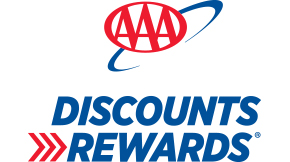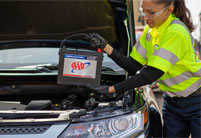It's National Drive Electric Week
It's National Drive Electric Week

It’s National Drive Electric Week (September 22 to October 1) and AAA has tips for drivers before they get behind the wheel of an electric vehicle (EV). The first time driving an EV might be surprising and overwhelming, but AAA has an easy way to remember what you need to know. It’s important to manage your CARBs (not a carburetor or the food) when it comes to EV driving to help avoid a “sugar” overload on the new technology but will also keep you craving more.
AAA First Time EV Driver Point of View (POV)
AAA conducted a focus group to better understand first-time drivers' experience in an EV. Respondents reported “driving years” from 13 to 45 years, with an average of 32.2 years behind the wheel as they tested two popular EV models. Through their POV, study participants identified CARBs to be aware of before/while driving an EV.
CHARGE:
EVs rely on batteries to power their electric motors and propel the wheels into motion. The battery's charge is essential for the vehicle's operation, and maintaining a full charge is crucial. To charge an EV, it must be connected to a charging station, which provides the necessary power source. Once connected, the EV's charging port and onboard charger work together to convert the external power into battery charge.
CHARGING LEVELS
Electric vehicles have the capability to charge at varying power output levels, which will affect both where you can charge the vehicle (at home or in public areas) and how long it will take to fully charge. When using a home charger, Level 1 or Level 2 charging equipment is typically utilized.
Level 1 (120V)
Charge your electric vehicle with Level 1 charging using a standard household outlet and the 120V charging cord that comes with the vehicle.
Level 2 (240V)
Level 2 charging uses 240 volts, like your oven, for faster charging of your electric vehicle.
DC Fast Charging
You can find DC fast chargers at public charging stations for a quicker charge time compared to Level 1 and 2 stations. These chargers are perfect if you need a boost of power in a shorter amount of time.
⚡ AAA TIPS 🔌
AT HOME:
• Locate the charging cable for charging and know how to charge the vehicle (how to open the charging connection door, where to release the charging cable when finished charging).
• To help alleviate range anxiety, plan to use only 60-70% of the driving range before charging.
• Sustained highway driving or extreme temperatures will erode the driving range quickly.
• Make a habit of recharging the vehicle before it gets below the 20% state of charge.
IN PUBLIC:
• Develop a recharge routine and plan for the necessary access to charging networks before attempting any trip (this sometimes includes joining a charging network and registering a credit card).
• If you plan to use public DC Fast charging, know what type of charger works with the car you are driving.
Use AAA’s TripTik Travel Planner to map out an upcoming road trip and identify EV charging stations along the way. Use the AAA Find a Charger tool to find the nearest charging station wherever you are in the country!
ACCELERATION:
EVs are generally faster than their gas-powered counterparts. In vehicles, torque is the rotational force created by an engine or motor that turns the wheels to make it move down the road. EVs need less time for energy to make it to the wheels compared to gasoline cars, which need time for fuel and air to burn and expand in the engine.
⚡ AAA TIPS 🔌 Acceleration can launch the vehicle quickly and at a fast distance and speed – increasing the possibility of a crash.
• Use a smooth accelerator pressure to help drive at a moderate speed and to maintain a safe distance behind other vehicles.
• Keep an eye on the speedometer until you adjust to what it feels like to drive an EV. Most EVs are developed and marketed as performance cars, SUVs, and trucks. The ability for rapid acceleration from a stand-still or at highway speed is exhilarating – but can be dangerous if either unexpected by a novice EV driver, or if used irresponsibly.
RIDE:
EVs don’t emit any engine or exhaust noise, which makes them much quieter than their gas counterparts. A slight sound from their tires and mild wind noise make these EVs quiet to drive. Handling of the vehicle can be appreciated more because of the low center of gravity, making the EV easier to turn at reasonable speeds. Inside the EV, the vehicle user interface dashboard incorporates modern technology and influences how users interact with EVs.
⚡ AAA TIPS 🔌 Give yourself the gift of time!
• Get familiar with all driver controls. Making mental logs of how to use the lights, wipers, stereo, heat, and air conditioning by understanding the use of and where the touchscreen interface is located is a must before starting to drive.
BRAKE:
In a gas-powered vehicle, the brake pads create friction to slow the wheels’ movement. The friction turns some of the kinetic energy of wheel rotation into heat and slows the vehicle.
In an EV, instead of coasting, the system automatically uses the electric drivetrain and (depending on settings) can cause the car to slow down without the brake pedal engaged. This is called Regenerative Braking. The EV captures the energy released during the braking process and uses it to recharge its battery. This makes EVs more efficient and helps to extend their overall range. A “jarring” feeling often kicks in the moment the driver takes their foot off the acceleration pedal.
⚡AAA TIPS 🔌
• Most EVs allow the adjustment to the sensitivity of regenerative braking. Setting this to a minimum for the first driver will help avoid the harsh sensation.
• Turning the setting up to increase levels of regenerative braking will save more energy that ultimately increases the EVs driving range.
RENT AN EV BEFORE YOU BUY:
Still trying to decide about purchasing an EV? No problem. Our partners at Hertz offer the largest variety of EV fleets in North America, basic how-to videos on different EV models, and educational articles on all things EV. Plus, AAA Members get exclusive discounts and benefits, making the EV adventure affordable and fun!










